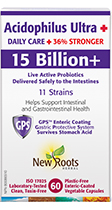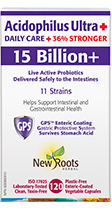Measure What Matters
The most important factor when choosing any treatment is that it helps a patient in the end. In certain cases, aspects of it may be unpleasant or inconvenient, but most patients understand that some temporary discomfort and investment in time and resources are necessary in order to get better. Delivery of expected benefits and effectiveness are key; this is why the need for shelf-stable probiotics seems trivial. It is difficult to understand all the hype. After all, we all have access to a fridge, and we all use it daily. The notion of providing “shelf-stable” probiotics due to “convenience” is counterintuitive.
Probiotics Like Cold Temperatures
The research is very clear: Probiotics behave like food. Refrigeration means that more of the probiotics found in the product survives over time. Even in studies using so-called “shelf-stable” products, the authors conclude that “higher storage temperature yielded lower stability in all strains or samples.” Bifidobacterium is particularly temperature-sensitive, and long-term stability tests on bifidobacteria show that the viability of live bacteria decreases with the length of time in storage and with increases in temperature. Storage of Bifidobacterium longum at 20 ℃ (room temperature) showed significantly higher mortality than at 4 ℃. Similar findings were made with Lactobacillus casei and paracasei after 39 weeks of storage at 4 ℃ and 22 ℃. The stability of the cultures was remarkably higher when stored under refrigeration at 4 ℃.
Who Benefits from “Shelf Stability”?
Here is what we know. Refrigeration is proven to help maintain the viability of all probiotics. Bacteria found in shelf-stable probiotics die off more quickly at room temperature. And the common production method for many shelf-stable probiotics is to overbuild the product to anticipate the die-off of probiotics. So one has to wonder: What are you really getting when you buy a shelf-stable probiotic twelve or even eighteen months after production?
Shelf stable probiotics serve the industry, not the consumer.
Selling a shelf-stable product decreases shipping costs and helps expand distribution into more grocery and pharmacy locations that do not have refrigerated sections dedicated to supplements. The unsuspecting customer ends up with a product composed of heat-resistant strains, chosen for their shelf properties and not for their health benefits.
 Does Shelf Stability Deliver on Expectations?
Does Shelf Stability Deliver on Expectations?
Lactobacillus and Bifidobacterium are the most studied probiotic genera for health benefits. Not surprisingly, they are most commonly used in food products and supplements. They are fragile, yet valuable therapeutic strains of probiotics, which require refrigeration to survive storage. Bifidobacterium probiotic strains—including B. infantis, B. breve, and B. plantarum—are among those that die off rapidly unless refrigerated. Yet together, they are the subject of thousands of studies showing their health benefits. Bifidobacterium infantis has been shown to be beneficial for those suffering from irritable bowel syndrome, ulcerative colitis, and chronic fatigue syndrome. B. breve has demonstrated benefits in patients with inflammatory bowel disease and may help maintain a healthy weight. B. plantarum is another well-researched probiotic strain with benefits for athletic performance, irritable bowel syndrome, and eczema. Omitting these strains from a multistrain formula and using more obscure and less-studied strains, simply because they are more stable at higher temperatures, seems ill-advised. Consumers’ health would be much better served if manufacturers selected proven beneficial strains, produced effective probiotic formulas, and kept them refrigerated.
Probiotics Have It Rough
Probiotics are living organisms with great potential, but face two major obstacles. First, they need to withstand variations in temperature and humidity during production, transport, and storage. Then, they are thrown into a harsh, inhospitable gastrointestinal environment designed to destroy them. Therefore, it is critical to use an enteric-coated product to ensure survival through the acidity of the stomach. In studies, only enteric-coated probiotics were able to resist degradation by harsh stomach acids. The survivability of enteric-coated probiotics through the stomach was substantially greater than non—enteric-coated probiotics, which were almost completely destroyed.
The Choice Is Yours
Research shows that using a probiotic that is refrigerated and enteric-coated will help improve the viability and effectiveness of the product. Shelf-stable probiotics may offer benefits for the industry, but can leave the consumer with a product that, unfortunately, falls regrettably short of expectations.
 Dr. Ludovic Brunel, ND
Dr. Ludovic Brunel, ND
Dr. Brunel has 15+ years’ of experience as a naturopathic doctor and practices in Calgary. His approach has always been to improve health outcomes by relying on the best research available.
elevatedhealthcare.ca

 Stores
Stores














